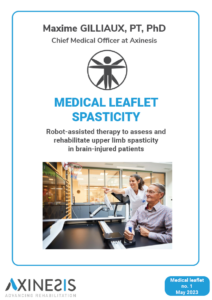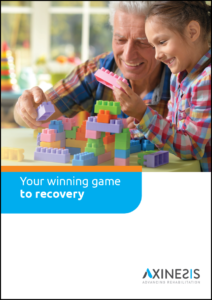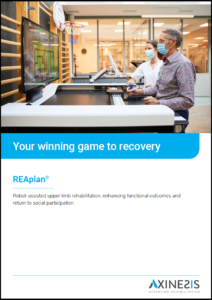Replays of the webinars
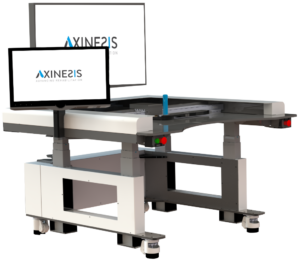
Using the REAplan® to assess and rehabilitate upper limb movements in brain injured patients
25/05/2023
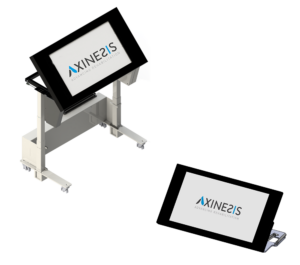
Using interactive technologies to promote intensive functional neurorehabilitation: from rehabilitation centre to home
25/01/2024
Medical leaflets
Downloads
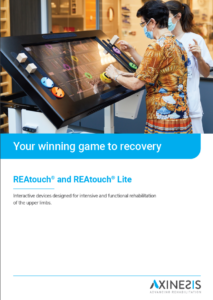
Product sheet REAtouch®/REAtouch® Lite
Links to scientific studies
Doumas I, et al. (2021).
Journal of NeuroEngineering and Rehabilitation. 18(1) DOI:10.1186/s12984-021-00889-1.
Assessment of the efficacy of serious games, implemented on diverse technological systems, targeting Upper Limb (UL) recovery after stroke. This meta-analysis showed that rehabilitation through serious games, targeting UL recovery after stroke, leads to better improvements, compared to conventional treatment, in three ICF-WHO components.
Keywords: Stroke; Upper extremity; Serious games; Virtual reality; Robotics
Evidence for a Window of Enhanced Plasticity in the Human Motor Cortex Following Ischemic Stroke.
Hordacre B, et al. (2021).
Neurorehabilitation and Neural Repair, 35(4):307-320.
Objective of this research is to look for evidence of synaptic plasticity in the human brain in the weeks and months after ischemic stroke. The results provide the first neurophysiological evidence consistent with a period of enhanced synaptic plasticity in the human brain after stroke. Behavioral training given during this period may be especially effective in supporting post-stroke recovery.
Keywords: Stroke; Plasticity; Recovery; Motor Cortex; Non-Invasive Brain Stimulation; Transcranial Magnetic Stimulation
Dehem S, et al. (2019).
Ann Phys Rehabil Med, 62(5):313-320.
This is a pragmatic, multicentric, single-blind, RCT to evaluate the effectiveness of upper-limb Robotic Assisted Therapy (RAT) used as partial substitution to conventional therapy in the early phase of stroke rehabilitation. Conclusion: For the same duration of daily rehabilitation, RAT combined with conventional therapy is more effective than conventional therapy alone to improve gross manual dexterity, upper-limb ability during functional tasks and patient social participation.
Keywords: Stroke; Upper extremity; Robotics; Rehabilitation; Recovery of function
Lee SH, et al. (2020).
Scientific Reports 10 (1) DOI:10.1038/s41598-020-58630-2.
This single-blinded, RCT aims to directly compare End Effector and Exo robots in rehabilitation of the upper limb in chronic stroke patients. Findings suggest that the End Effector robot intervention is better than the Exo robot intervention with regard to activity (WMFT–FAS and WMFT–Time) and participation (SIS–Participation) among chronic stroke patients with moderate-to-severe upper limb impairment.
Keywords: End Effector Robot; Exo robot; Chronic stroke; Rehabilitation
Effectiveness of paediatric occupational therapy for children with disabilities: A systematic review.
Novak I, et al. (2019).
Australian Occupational Therapy Journal, 66(3):258-273.
The aim of this systematic review is to summarise the best-available intervention evidence for children with disabilities, to assist families and therapists choose effective care. Evidence supports 40 intervention indications, with the greatest number at the activities-level of the International Classification of Function.
Keywords: Disability; Intervention and service provision; Occupational therapy;
Intensive upper- and lower-extremity training for children with bilateral cerebral palsy: a quasi-randomized trial.
Bleyenheuft Y, et al. (2017).
Developmental Medicine & Child Neurolology, 59(6):625-633.
This research aims to find out whether children with bilateral CP would benefit from the HABIT-ILE approach. The conclusion is that HABIT-ILE is efficacious for improving both upper- and lower-extremity function in children with bilateral CP.
Keywords: Upper extremity rehabilitation; Lower extremity rehabilitation; HABIT-ILE; Cerebral palsy; Bimanual intensive therapy
Robotic-assisted serious game for motor and cognitive post-stroke rehabilitation.
Dehem S, Heins S, Montedoro V, et al. (2017).
IEEE 5th International Conference on Serious Games and Applications for Health (SeGAH), DOI:10.1109/SeGAH.2017.7939262.
The aim of the project was to develop a serious game to simultaneously improve motor and cognitive deficits. The outcome was a Robotic-assisted target-pointing game on the REAplan to rehabilitate both cognitive and motor impairments following stroke.
Keywords: Serious game; Robotic assisted-rehabilitation; Stroke; Hemineglect; Hemiparesis; Upper limb; Motivation; REAplan
Upper limb robot-assisted therapy in cerebral palsy: a single-blind randomized controlled trial.
Gilliaux M, et al. (2015).
Neurorehabilitation and Neural Repair, 29(2):183-92.
Assessment of Robotic Assisted Therapy (RAT) of the upper limbs with the REAplan in children with Cerebral Palsy. This single-blind RCT provides the first evidence that RAT is effective in children with Cerebral Palsy.
Keywords: Rehabilitation; Robotics; Cerebral palsy; Kinematics; Motor learning; Pediatrics; International Classification of Functioning; Disability and Health
Hand and Arm Bimanual Intensive Therapy Including Lower Extremity (HABIT-ILE) in Children With Unilateral Spastic Cerebral Palsy: A Randomized Trial.
Bleyenheuft Y, et al. (2015).
Neurorehabilitation and Neural Repair, 29(7):645-57.
The objective of this research is to determine the efficacy of Hand and Arm Bimanual Intensive Therapy Including Lower Extremity (HABIT-ILE) for children with USCP. The findings suggest that combined upper and lower extremity in an intensive training protocol may be efficacious for improving both upper and lower extremity function in children with USCP.
Keywords: Upper extremity rehabilitation; Lower extremity rehabilitation; Cerebral palsy; Bimanual training; Hand; Posture; Motor skill learning; Intensive training; Neurorehabilitation; Gait; Dose; Hemiplegia; Children
Rééducation et réadaptation de la fonction motrice de l’appareil locomoteur des personnes diagnostiquées de paralysie cérébrale.
Haute Autorité de Santé (HAS), October 2021.
Recommendations for good practice (GPR) are defined by HAS in the treatment of Cerebral Palsy. Therapy proposals are developed methodically to help the practitioner and the patient to seek the most appropriate care in given clinical circumstances.
In addition to conventional functional rehabilitation, HAS recommends to develop HABIT and HABIT-ILE intensive therapies, which consist of improving motor functions through play, but also to use interactive and motion-controlled computer games for young people in order to improve gross motor skills.
